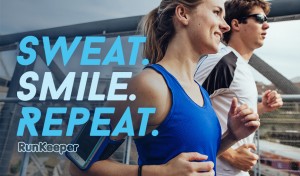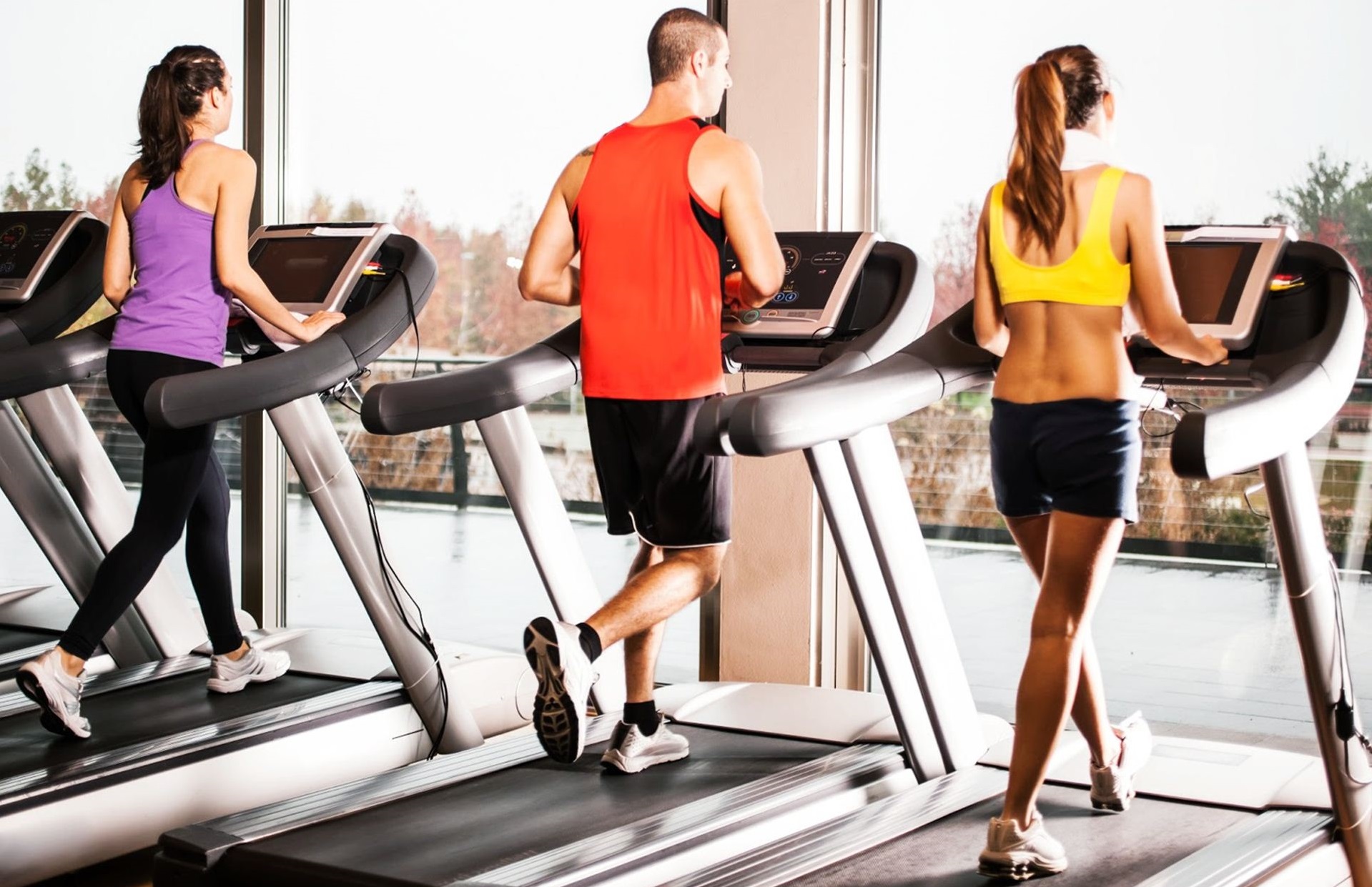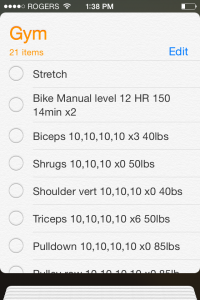I started working out this spring for the first time at my local Good Life and one of the first things I knew I wanted to do was to know when I could ramp up my sets and reps. I’m a big user of the Apple iPhone Reminders app so I figured I’d put it to good use recording my workout:
But why track your workout like this? Because working out is a long-term activity. Tracking your stats in a simple, easy way like this will help remind you where you’ve been, where you’ve gotten to, and provide a clear path of improvement so you’ll be on an upward workout trend and not plateaued or even going down (how would you know without tracking)? You’ll feel good about continuous improvement and more confident because you know where you’ve come from and where you’re going. I think most people would find tracking their workout tedious on paper or they just don’t know what workout app to use, etc. So I figured I show how it can be done with an app that most people have already.
So, what you have above is a Gym tab in the Reminders app and I simply list all my exercises in the order that I do them. I also record any pertinent settings for the machine (like Level 12 and target heart rate 150 for the bicycle). Then I record the sets and reps (“10,10,10,10” – ie. 4 sets of 10 reps each). I record the workout count (“x4”) meaning how many times I’ve done it (usually indicates once per workout). I also record the weight.
See how compact and easy it is to review your current workout when you record it like that? And it’s in the Reminders app that I use for everything else so it’s easy and convenient to use.
For the record: I’m not a licensed gym trainer, physiotherapist or doctor. The ideas in this post are from my personal experience and I hope they can help some beginners as well.
Following I’ve included some personal thoughts, recommendations and anecdotes about my experience at the gym since I’ve started. I hope it helps someone out there get started as well!
What’s your goal in 6 months to a year?
For me, I’m aiming for general fitness and to reduce body fat. My friend is aiming at bulking up. What’s your goal? It’s important to know for yourself, as you’ll discover below, as it will impact how you setup your workout, what you put in and what you take out, over time so you can get to your goals without getting bogged down in too much other stuff.
What’s your timeline? I recommend thinking in intervals of months such as 3, 6 or 12 months. You can’t expect super change in just one month or less. That means you’ll have to keep at it, keep going, it will be worth it! :) At 3 and 6 months intervals you should be very encouraged by your progress and at 12 months you should be getting close to your original goals. But, of course, as you start hitting your goals you’ll start seeing where you can improve all over again. Have fun and enjoy achieving your desired results!
Start at a Comfortable Exercise Level
Your workout will be different so don’t use my 4 sets of 10 reps each for yourself. Start at something you’re comfortable with and feel good about. It will be important for your morale and feeling of accomplishment when we get to ramping up these numbers.
Workout Count
The workout count (ie. “x4”) tracks how many times you’ve done this particular exercise-sets-reps-weight combination. When you start on a new combo, you’ll probably feel less than confident, it will feel harder for you than the previous lesser combo. So I use this number to remind me how many times I’ve done it and by about the 5-6th time I’m usually feeling confident with it. At that point, you can consider ramping up.
Ramping Up
Ramping up usually means increasing the duration, sets, or reps of the exercise. For example, I recently increased my biking from 12min to 14min, and I also increased my biceps exercise from 35lbs to 40lbs. When you ramp up then you also reset your workout count so you know when it will be time to ramp up again.
Beginner’s Tip: I used to have a “ramp day”, like other people’s “leg day” or “back day” where they focus exercises on those body areas, I would have a ramp day where I increased every exercise’s duration, sets, reps, or weight. Don’t do that! Your body will progress at different intervals and you don’t want to hurt yourself by overdoing your exercises. Instead, use the workout count as an indicator to when is a good, safer time to increase your exercise durations, sets, reps or weight. The workout count is only an indicator. You know best when you’re ready. Personally, I feel ready to ramp when my exercise begins to feel a little easier. If it starts to feel easy, that’s probably a good sign it’s time to ramp. If you’re struggling near the end of your sets and reps then it’s not time to ramp but if you’re not really struggling by the end of your sets and reps then go ahead and try a ramp up.
Going Gung Ho, Or Not
When I first started I quickly accumulated 20+ exercises I would do each time at the gym – four times per week for me – and some were working generally the same body areas as other exercises. This is certainly doable but some weeks things get in the way and you begin to reconsider your time. You start to think things like “oh I’ve already done a lot of house work today, I’m not up to a full workout.” And that’s okay! :) When this happens, think about reducing your workout or targeting your workout to core fitness goals.
Think about reducing exercises that may be working mostly the same areas. For example, personally I no longer do pull downs or pulley rows. These work the top of your shoulders and the top and middle portions of your back. That’s great, but other exercises also tend to work those areas, as well, although to a lesser degree. I’m fine with that now because it means I can get
Target the areas you really want to see improvement in and reduce or eliminate other exercises. Personally, my goal is to reduce body fat, especially around the stomach, so I’ve increased my cardio (biking for me) and reduced weight training which builds muscle. I still do a number of weight training exercises such as biceps and triceps but have taken away others.
You’re an individual and you have your own goals: Target your goals and don’t worry about achieving what other people are trying to achieve. You will be most happy when you achieve your own goals.
When to Stop Ramping
At some point, you begin to say yourself “I can keep ramping up forever, but what am I really achieving? Do I really want to look like Arnold Schwarzenegger?” I asked myself this when I started feeling pains and tweaks and difficulties with pulldowns and pulley rows. Those are awkward machines to work with at times. Eventually, I came to the conclusion that, yes, I could keep doing these and keep increasing the weights, but I don’t really want that. Personally, my goal is a general fitness level, not some body-builder type so I stopped ramping. Although, if you want that goal then go right head. The goal is to achieve your goal. :)
When to Increase Duration, Sets or Reps
When you really want to target an area. I really want to target stomach fat and abs muscle so I now do 10 sets of stomach crunches (in two separate exercises with other exercises in between for rest).
I had an interesting problem. I’m into simulation racing and that implies a lot of pedal footwork for throttle, brake and clutch. I started to feel pain in my heel (which means it’s Achille’s Tendonitis) so I figured it was time to take a rest and later I figured it would be a good idea to do training on my heels at the gym. I started with 4 sets of 10 reps each but, when I still felt discomfort working the pedals after a few weeks, I figured it was time to really focus on them so I’ve gone to 5 sets. I may increase it again when I feel ready.
When to Stop an Exercise
When you feel pain. Not the usual soreness of a good workout but pain. When you tear a muscle you know the difference between workout soreness and a pain that inhibits the free motion of your body. It’s like if you pull a muscle in your back and you find it uncomfortable to sleep in any position. That’s something you don’t workout because you’ll make it worse.
When I was a teenager I tore my ACL and had it surgically repaired but my physiotherapy wasn’t good enough (my fault) and now it’s not as tight in that knee as it should be in a healthy individual. This can lead to a dislocation feeling at random times while walking anywhere. It’s painful. I found this was happening more after my workouts so I deduced it was probably leg extensions or leg curls so I stopped those. That’s just my real life example of when to stop a particular exercise
Looking Good, Or Not
There’s a lot of good looking people at the gym. If you’re like me and not so good looking you might be worried about working up a real sweat, after all those good looking people don’t look sweat stained to me! Don’t worry about it. :) They’re not going to bite, they’re average, good people like you and me.
So if you have body you’re trying to reach don’t worry about looking good. In fact, in the end you’ll gain a lot of respect because people know you’re there to do a serious workout. And you’ll thank yourself in the end when all the time you’ve put in the gym results in a body that you like.
Be That Gym Guy or Girl Who Smiles
 One of the first atmosphere things you’ll notice at the gym is a self-conscious ‘no direct eye contact’ thing going on. I don’t quite know what it is and sometimes I feel the same way. It’s like we’re all self-consciously forcing ourselves not to look at others for fear of them thinking we’re looking at them in an inappropriate way? I don’t know but I do know those people who smile and might talk with their friends help create a better atmosphere. Just throw a smile at someone you’re passing. They’ll likely return it and it makes the whole place friendlier and warmer. :)
One of the first atmosphere things you’ll notice at the gym is a self-conscious ‘no direct eye contact’ thing going on. I don’t quite know what it is and sometimes I feel the same way. It’s like we’re all self-consciously forcing ourselves not to look at others for fear of them thinking we’re looking at them in an inappropriate way? I don’t know but I do know those people who smile and might talk with their friends help create a better atmosphere. Just throw a smile at someone you’re passing. They’ll likely return it and it makes the whole place friendlier and warmer. :)
How to Pick a Gym
I picked Good Life because my friend was already going there. Good Life has a good reputation for everything except price, billing issues when you want to stop, and pushy salesmen style business and personal trainers. If you’re willing to commit to a year, however, and you can put up with a few pushy tactics then it might be for you. Luckily for me, our local gym is not crazy on the pushy sales. I haven’t been approached for anything beyond my one year plan I signed on the first day. That’s great.
I can’t really comment on other gyms but I’m sure there are good ones out there. Good Life may be the best choice for beginners or, if you have a friend at another one, that can also be a good choice if they give you a good recommendation on it. Make sure it’s professionally run, has a quality looking equipment, is airy, has air conditioning, has good change rooms and relatively clean shower facilities, and is in a safe-ish area.
Have Fun and Enjoy Yourself
No, seriously. Have fun and enjoy yourself with your workouts. Don’t make it a chore. Workouts can be a life-long, pleasant experience of continuous improvement and increased self-confidence if you realize it’s a long-term objective to reach your own personal goals. When you look at yourself in the gym mirror and think you don’t look good yet tell yourself “keep working and ask yourself again in 6 months.” Guaranteed you will look much better if you keep going now. :)

